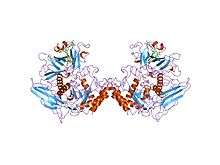Glycoside hydrolase family 2
| Glycosyl hydrolases family 2, sugar binding domain | |||||||||
|---|---|---|---|---|---|---|---|---|---|
 e. coli (lacz) beta-galactosidase-trapped 2-deoxy-galactosyl enzyme intermediate | |||||||||
| Identifiers | |||||||||
| Symbol | Glyco_hydro_2_N | ||||||||
| Pfam | PF02837 | ||||||||
| Pfam clan | CL0202 | ||||||||
| InterPro | IPR006104 | ||||||||
| PROSITE | PDOC00531 | ||||||||
| SCOP | 1bgl | ||||||||
| SUPERFAMILY | 1bgl | ||||||||
| CAZy | GH2 | ||||||||
| |||||||||
| Glycosyl hydrolases family 2 | |||||||||
|---|---|---|---|---|---|---|---|---|---|
 e. coli (lacz) beta-galactosidase-trapped 2-deoxy-galactosyl enzyme intermediate | |||||||||
| Identifiers | |||||||||
| Symbol | Glyco_hydro_2 | ||||||||
| Pfam | PF00703 | ||||||||
| InterPro | IPR006102 | ||||||||
| PROSITE | PDOC00531 | ||||||||
| SCOP | 1bgl | ||||||||
| SUPERFAMILY | 1bgl | ||||||||
| CAZy | GH2 | ||||||||
| |||||||||
| Glycosyl hydrolases family 2, TIM barrel domain | |||||||||
|---|---|---|---|---|---|---|---|---|---|
 human beta-glucuronidase at 2.6 a resolution | |||||||||
| Identifiers | |||||||||
| Symbol | Glyco_hydro_2_C | ||||||||
| Pfam | PF02836 | ||||||||
| Pfam clan | CL0058 | ||||||||
| InterPro | IPR006103 | ||||||||
| PROSITE | PDOC00531 | ||||||||
| SCOP | 1bgl | ||||||||
| SUPERFAMILY | 1bgl | ||||||||
| CAZy | GH2 | ||||||||
| |||||||||
In molecular biology, Glycoside hydrolase family 2 is a family of glycoside hydrolases.
Glycoside hydrolases EC 3.2.1. are a widespread group of enzymes that hydrolyse the glycosidic bond between two or more carbohydrates, or between a carbohydrate and a non-carbohydrate moiety. A classification system for glycoside hydrolases, based on sequence similarity, has led to the definition of >100 different families.[1][2][3] This classification is available on the CAZy(http://www.cazy.org/GH1.html) web site,[4] and also discussed at CAZypedia, an online encyclopedia of carbohydrate active enzymes.[5]
Glycoside hydrolase family 2[6] comprises enzymes with several known activities: beta-galactosidase (EC 3.2.1.23); beta-mannosidase (EC 3.2.1.25); beta-glucuronidase (EC 3.2.1.31). These enzymes contain a conserved glutamic acid residue which has been shown,[7] in Escherichia coli lacZ (P00722), to be the general acid/base catalyst in the active site of the enzyme.
The catalytic domain of Beta-galactosidases have a TIM barrel core surrounded several other largely beta domains.[8] The sugar binding domain of these proteins has a jelly-roll fold.[8] These enzymes also include an immunoglobulin-like beta-sandwich domain.[8]
External links
References
- ↑ Henrissat B, Callebaut I, Mornon JP, Fabrega S, Lehn P, Davies G (1995). "Conserved catalytic machinery and the prediction of a common fold for several families of glycosyl hydrolases". Proc. Natl. Acad. Sci. U.S.A. 92 (15): 7090–7094. doi:10.1073/pnas.92.15.7090. PMC 41477
 . PMID 7624375.
. PMID 7624375. - ↑ Henrissat B, Davies G (1995). "Structures and mechanisms of glycosyl hydrolases". Structure. 3 (9): 853–859. doi:10.1016/S0969-2126(01)00220-9. PMID 8535779.
- ↑ Bairoch, A. "Classification of glycosyl hydrolase families and index of glycosyl hydrolase entries in SWISS-PROT". 1999.
- ↑ Henrissat, B. and Coutinho P.M. "Carbohydrate-Active Enzymes server". 1999.
- ↑ CAZypedia, an online encyclopedia of carbohydrate-active enzymes.
- ↑ Withers S. "Glycoside Hydrolase Family 2 (GH_2)". CAZypedia - carbohydrate active enzymes. Retrieved 2010-10-10.
- ↑ Aebersold R, Withers SG, Gebler JC (1992). "Glu-537, not Glu-461, is the nucleophile in the active site of (lac Z) beta-galactosidase from Escherichia coli". J. Biol. Chem. 267 (16): 11126–11130. PMID 1350782.
- 1 2 3 Matthews BW, Jacobson RH, Zhang XJ, DuBose RF (1994). "Three-dimensional structure of beta-galactosidase from E. coli". Nature. 369 (6483): 761–766. doi:10.1038/369761a0. PMID 8008071.
This article incorporates text from the public domain Pfam and InterPro IPR006102
This article incorporates text from the public domain Pfam and InterPro IPR006103
This article incorporates text from the public domain Pfam and InterPro IPR006104